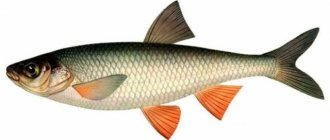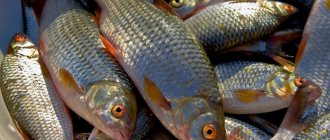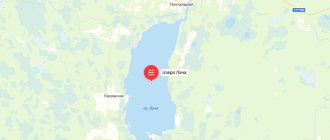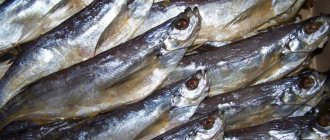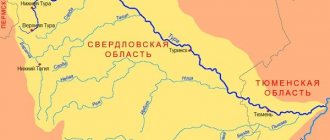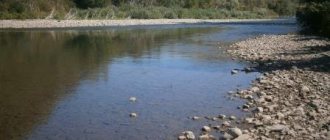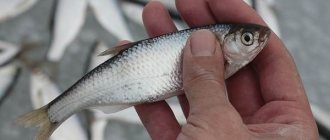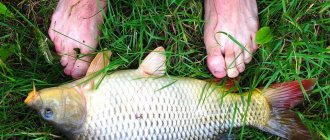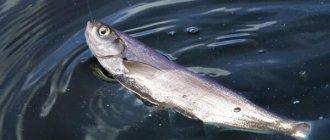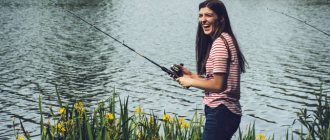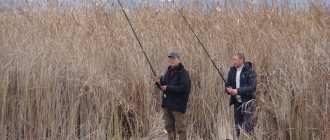Tackle for catching chebak
Chebak is a medium-sized fish, with a maximum weight of up to 700 grams.
Therefore, the basis for the tackle is a thin monofilament fishing line 0.12-0.2 mm or a braided cord up to 0.1 mm. Hooks are used No. 3-No. 5, the length of the fore-end varies depending on the attachments and baits used. To catch a chebak, use the following set of fishing equipment: • Float rod. 4-7 meter Bolognese rods with 3-15 grams of dough and fast action are well suited. Any type of reel can be used, but the best sensitivity of the gear will be provided by a light “inertia”. The sinker is used in a round or spindle-shaped form, so as not to catch tufts of algae, and is attached immediately behind the leash. The thickness of the leash should be significantly less than the main fishing line, and the length should be 10-20 cm. Fluorocarbon is well suited for the leash, which becomes almost invisible in the water. A silicone stopper and a drop-shaped sliding float weighing 5-10 grams are attached to the main fishing line. This design of equipment makes it possible to fish both the bottom and the surface, fish with a wire and use slow-sinking bait (insects). • Bottom tackle (feeder). Used for catching chebak in the twilight hours (morning-evening) and in the cold season. Its main advantage is long casting and the ability to catch large or trophy fish. Rods from 4 to 5 meters with a dough of 30-100 g are used. and a sensitive tip. A good catch is achieved by installing feeder equipment, consisting of an anti-twist to which a feeder set aside is attached and a fluorocarbon leash 25-35 cm long with an attached hook. Various cereals are used to fill the feeder.
• Ultralight. The chebak, like the rudd, reaches a weight of over 100 grams. exhibits some predatory tendencies and can be caught well with the smallest spinners when retrieved quickly. In muddy water, bright golden or yellow spoons are used; in clear water, silver “spinners” with red splashes are unrivaled. • Tackle for vertical jig fishing. This method is effective and efficient if there is too much vegetation in the chosen fishing area. The equipment consists only of a round heavy jig tied to the main line and a sensitive nod. For convenient use of the tackle and quick hooking of fish, the main line is reduced to half the rod. Next, the usual process of fishing with a jig takes place, involving a watercraft or the angler wading into the water. • Winter gear. On ice, chebak fishing is carried out using simple “filly” fishing rods and classic fishing rods with a reel, whip and sensitive nod. Light jigs of yellowish, reddish shades or white round (oval) shape are used. The fishing line used is ultra-thin - 0.07-0.1 mm. When fishing in a strong current, the weight of jigs increases, and the thickness of the fishing line can be 0.12-0.15 mm. A popular method of fishing for chebak is fishing with “standing” tackle with light floats weighing 1.5-2 g. The bait is burdock moth larva, worm, maggot, bloodworm.
What to catch chebak with - tackle and bait
The gear and baits required for catching sorog may vary depending on the season.
In spring and summer
During this period, sorog is caught mainly with plant and animal baits, but some fishermen also use spinning rods. When fishing with a float rod, you can use a thin line, since this fish does not resist much when playing. The advantage of a thin line is that it scares away the fish less and helps to improve the bite.
Any rod is suitable for catching sorog. It doesn't have to be durable or expensive. A light rod is considered suitable for catching chebak, since the hand will get less tired during intense biting. A main line with a diameter of 0.2 mm, a thinner leader, a small weight and a sensitive float are suitable. It is not necessary to use a coil.
When catching sorogi on a float rod or feeder in the summer, the following baits are used:
- dung or other earthworms;
- bloodworm;
- maggot;
- bark beetle;
- caddisfly;
- lamprey larva;
- insects;
- dough or bread;
- pearl barley.
The most suitable nozzle is selected experimentally. You need to try all the baits and find out which one is the most effective.
in autumn
In autumn, the chebak becomes cautious and timid. This is due to the fact that the water becomes colder and clearer.
Summer gear is not suitable for catching autumn hornbill, as it becomes wary of fishing line with a diameter of 0.15 mm or more. In autumn, it is recommended to use a main line with a cross-section of no more than 0.12 mm. The leash should be transparent, thin and durable. For a leash, it is best to use a fishing line with a diameter of 0.1 mm.
Hooks should also not arouse suspicion in the fish. For autumn fishing, hooks No. 3−5 according to the Russian classification, or No. 20−23 according to Western standards, are suitable. Hooks should be thin and sharp.
The tackle is equipped with a sensitive float with a thin tip. Its load capacity should not exceed 0.5 g. A homemade goose feather float is considered more sensitive than any artificial analogues presented in fishing stores. The autumn chebak bites sluggishly, and its bite can be missed due to an insufficiently sensitive float. If the water is clear, then the float should not be too bright. A lead ball is used as a sinker.
In the autumn, it is best to use bloodworms, maggots, bark beetles, caddis flies and lamprey larvae as bait.
Catching chebak in winter can be regular. But for this you need to experiment with lures and baits for winter fishing. Contrary to popular belief, fish are caught in the cold season not only with bloodworms, but also with vegetable baits such as bread, dough or semolina.
When fishing for chebak in winter, artificial baits are also used, for example, artificial flavored bloodworms. This bait is larger than its natural counterpart, but it attracts small fish due to its strong smell. The colors of the baits to which the sorog reacts in winter may differ depending on the body of water.
In the cold season, you can use winter float fishing rods with no-attachment jigs. It is recommended to fish with 2-3 gear at once, since this way you will quickly find the area where the fish is standing.
To catch chebak in winter, the equipment on your fishing rod should consist of a light float weighing 1-2 g and a red, white or yellow jig. For unknown reasons, the large sorog prefers baitless jigs. In addition, to attract her, you will need feeding. This fish is attracted to sweet smells, and therefore bait for chebak should contain ingredients such as honey and vanilla.
Chebak is an omnivorous fish and can be caught using bait of various origins. If you take the right bait, you can catch it with a spinning rod, despite the fact that the chebak is more of a peaceful fish. At the same time, not everyone knows that this is possible and tries to catch chebak with classic tackle - float rods.
The chebak does not offer strong resistance to the fisherman, so thin fishing lines can be used, which contributes to the normal bite of this fish. Thin fishing lines do not alert the fish.
For fishing, you can choose a regular fishing rod, but it is quite light. If the chebak starts to bite, then the fishing pace is so high that a heavier fishing rod will be remembered for a long time. As for the fishing line, its diameter can be no more than 0.2 mm. A light sinker and a sensitive float are enough. The reel is not necessary, but it makes the tackle more practical and modern. To catch chebak you can use the following baits:
- dung worm;
- bloodworm;
- maggot;
- bark beetle;
- caddisfly;
- lamprey larvae;
- various insects;
- bread;
- barley;
- dough, etc.
Chebak, like any other fish, is unpredictable, so it can bite on any of the listed baits. If you don’t take several baits with you at the same time, you may end up without a bite. Only as a result of experimental casts can one determine which bait the chebak has chosen for today.
If you pick up an ultralight spinning rod and select the right baits, then fishing can be very productive. To catch it, spinners and spoons of the smallest sizes are suitable. If you stop at larger baits, with the hope of catching a larger chebak, then you may not see any bites.
Despite the fact that it is caught using a spinning rod, it does not bite on live bait, so no one practices catching chebak with live bait. If this happens and you manage to catch this fish with live bait, then this is more of an accident, but not a pattern.
The diet of the chebak is quite varied; it bites both on bait of animal origin and on plant bait. And the most interesting thing is that this seemingly peaceful fish can be caught perfectly on a spinning rod if you choose the right bait.
But not all fishermen know that chebak is caught using a spinning rod, so catching chebak using float rods is more common. Although the resistance of the chebak during fishing is felt, it is quite weak, which allows the use of thinner tackle. And this, as is known, contributes to a more active bite of any fish.
Any fishing rod is suitable for catching chebak; it does not have to be super strong or very expensive, but it is best to choose a light rod, because if the chebak bite starts, you will have to work a lot with the rod. There will be enough fishing line up to 0.2 mm in diameter, a light weight and a small and sensitive float. A fishing rod reel is optional, but its presence will make folding and unfolding the gear easier.
To catch chebak on a float rod, you can use the following attachments:
- muckworm;
- bloodworm;
- maggot;
- bark beetle;
- caddisfly;
- lamprey larvae;
- various insects;
- bread;
- pearl barley;
- dough, etc.
The chebak may like any of these attachments, but at the same time, any attachment may not be to his liking. To avoid fishing failures when catching chebak, it is best to have several types of bait with you. Through experiments, find out what is better for catching chebak and use it in the future.
Catching chebak with a spinning rod can be very productive. To catch chebak, you should use a light spinning rod with minimal casting. To catch it, it is best to use small spinners and spoons. The sizes of the spinners are No. 0-1. When using larger spinners, you may not see the chebak bite.
It is worth noting that although the chebak is excellently caught on spinning baits, it does not bite on live bait. At least, catching chebak with live bait is not practiced, and if such bites happen, it is more likely an accident.
It also happens: Nozzles for catching carp in a mountain river || How to catch carp
Catching chebak with a float rod is quite effective; you can also use a donka. Fishing with this gear will not cause any difficulties. However, there is a third way - catching chebak with a small rotating spoon. You need to take the smallest spoon and cast it a little further than the chebak family.
It is important to ensure that the spoon goes tangentially. In this case, the bite will not take long to arrive. It is also worth considering the color of the spinner. If the water in which fishing is carried out is cloudy, it is necessary to take light colors. These colors can be white or yellow. In clear water, any color will work, but the best lure is silver with red dots.
Catching chebak with a float rod is quite effective; you can also use a donka
As mentioned earlier, the chebak bites on almost any bait. And if a fisherman attacks a chebak’s family, he will not go home without a catch. Although the fish is undemanding when it comes to bait, it is worth noting that it also has its “favorite dishes.”
List of the most suitable baits:
- worm;
- caddisfly;
- maggot;
- dough;
- corn;
- porridge and bread;
- grasshopper;
- moths;
- dragonflies;
- lamprey larvae.
This list is unique for any time of year. But choosing one or another attachment is extremely difficult. For each new fishing trip, it is necessary to alternately select bait that is suitable for a particular school.
Bait for chebak in the summer also has its own characteristics, it all depends on the place where you fish. Here the best choice would be complementary feeding based on bloodworms and coastal soil. It is also worth considering the option of a mixture based on sweet cookies, which must be pre-soaked. If we are talking about a body of water with a current, the best choice would be fine-grained breadcrumbs, grain bran, etc.
The best flavoring is vanilla. However, if you couldn’t find a flavor with a pure vanilla scent, flavors with the scent of coriander, anise, chocolate and almond, hemp, caramel and others are suitable.
Most often, roach fishing is done with a float rod; you can also use a fly rod. But roaches are rarely caught on the feeder. The rod can be folding or solid, it doesn't matter. The length of the rod can vary from 2 to 5 meters.
In areas where the depth increases gradually, the fishing rod can be cast far. But on banks that sharply gain depth, you shouldn’t cast your fishing rod too far. In this case, it is recommended to use a shorter rod; a long one will be inconvenient to use.
- The fishing line should not be thick; small roaches simply will not bite the wrong fishing line.
- The best option would be a fishing line thickness of 0.1-0.15 millimeters.
- The hook also should not be large; hooks No. 4-6 are suitable. If you take a larger hook, the bait will be too big or the hook will stick out, and this will have a bad effect on the bite.
- It is best to choose a float that is light and inconspicuous. It must have a thin antenna and high sensitivity, only with such a float any bite will not go unnoticed.
- The sinker is selected based on the depth of the reservoir, the weight of the float and the selected bait.
- The bait should be located at a short distance from the bottom; the bait should not be allowed to sink to the bottom. The roach does not take bait from the bottom at all.
- The reel is rarely used for roach fishing. But the hook and weight can be replaced with a light-colored jig. In this case, it is better to replace the float with a nod.
Fish bait
In order to attract the attention of the fish to the fishing spot and directly to the bait, it is necessary to use bait. This is especially necessary if the bottom fishing method is chosen.
Home-prepared feed or purchased dry substance can serve as complementary feeding. The last option is quite simple to use - you just need to pour the capacity of the bag into a container and add water from the reservoir. Next, carefully move and form small balls, and then throw 3-5 pieces into the intended fishing spot. But as practice shows, it is better to prepare the aromatic mixture yourself at home. Moreover, almost all the necessary ingredients are always at hand.
Option #1
- Initially, you will need a bucket (3-4 liters) in which all the components of the porridge will be mixed.
- You need to boil about 1 kg of millet in a saucepan, but make sure that it does not turn into porridge, but is crumbly. After cooling, the millet is poured into a bucket.
- 0.5-0.7 kg of feed is poured on top of the millet.
- Next, add a little bran (150-200 g) and a pack of breadcrumbs. You can also add a little flour.
- Then add 100 g of coconut flakes and finely chopped maggots and bloodworms.
- When all the components are inside the bucket, there is no need to mix them before leaving for the fishing site.
- Only upon arrival for fishing, initially a little water from the reservoir is added to the bucket and everything is thoroughly mixed until the “porridge” acquires the desired thickness.
Balls are formed from this substance and randomly thrown into the water at the place where sabrefish are caught.
Option No. 2
The procedure for preparing bait:
- You can use an old unnecessary pan as a vessel for future bait. You need to pour 150g of peas into it and cook until fully cooked.
- During the cooking process you need to add 80-100 g of flour.
- After this, feed and a little wheat cereal are added to the pan.
- Next, everything is thoroughly mixed and left for several hours to “swell.”
- If there is some water left in the vessel, it must be drained.
- After arriving at the fishing site, chopped maggots and worms are added to the mixture.
- The entire mixture is mixed again.
- When the “porridge” is ready, balls are formed from it and thrown into the water in a heap.
- These homemade “porridges”, after being thrown into the water under the influence of the current, form a fragrant cloud, the smell of which spreads over a long distance, which is what attracts saberfish.
Tips from experienced people for catching bleak in the spring
- At the time when the fisherman needs to change gear or take a break, feeding should not be stopped, otherwise the flock can easily swim further to dissect the water area. To prevent this from happening, wrap a rope around a large piece of bread and throw it into the feeding area.
- Fishing for bleak in the spring is successful during those periods when other fish in the reservoir are sick and recovering from spawning. You should not take breaks from fishing at this time, because the caught bleak can be properly dried or made into delicious sprats.
- Bleak cannot be considered an extremely timid fish, however, silence must still be observed while fishing, since panic can quickly spread throughout the entire school and disrupt it from its place.
Periods of active biting
To find out how to catch chebak, you need to take into account that it is active all year round, but spring is considered the most favorable season. During this period, the chebak experiences pre-spawning gluttony. In spring, this fish is not picky and reacts to any bait.
https://youtube.com/watch?v=Bkq1q5osDNA
In summer, the intensity of the bite decreases. During this period, fish bite throughout the daylight hours, but the catches consist mainly of small individuals. Larger specimens are active at dawn and dusk.
Read: Catching bream with a ring
In the fall, the fish begin to become active again, trying to gain fat mass before the cold winter. She begins to peck much more intensely than in summer. At the same time, she begins to show increased interest in baits of animal origin, and plant baits fade into the background.
Climatic conditions have a great influence on the intensity of the bite. In the spring, this fish moves actively in search of food before thunderstorms, but a sudden change in weather can negatively affect its appetite. The most favorable weather is stable weather that does not change for several days.
Experienced fishermen know that sorog, like many other varieties of white fish, bites poorly in January. In winter, it is caught during the formation of ice cover, which can last until mid-January. The bite resumes from mid-February and gradually intensifies as the weather gets warmer.
The low activity of fish in January is explained by oxygen starvation. During this period, it descends into deep holes or looks for the mouths of small rivers and streams that bring fresh water. In such places this fish can be caught in January. Cases have been recorded when the sorog in the middle of winter pecked at depths of more than 6 m, but at the same time ignored bait in other places.
In winter, it is best to catch chebak in the early morning and afternoon. The bite stops after the sun goes down. Winter weather matters too. The most intense bite is observed when the bright sun shines for 2-3 days. On cloudy days, fish feed mainly at sunset.
On large rivers, sorog is caught in winter in bays and oxbow lakes. The mistake of many novice anglers is that in winter they try to fish in the current. But during the cold months, the fish avoid such places and try to stick to shallow areas where the water is warmer.
Roach bait
The roach is a common fish that lives in almost any body of water. Although it does not reach large sizes, it is interesting for fishermen to hunt. The usual weight of fish does not exceed 100 grams. Catching roach in the summer with a float rod is in demand even among boys.
Roaches prefer clean water, preferably running water. The fish does not like strong currents, and you should not look for them in ponds with mud. The roach is usually found in schools and stays in coastal vegetation. She doesn't like deep waters. Catching roach in summer is not special. The main thing is to choose a suitable place. And such a place is a shallow depth in the coastal zone and the equipment for this will require the simplest.
- It is necessary to attach a light float to the main line; it is better to attach it using two cambrics, it is reliable and simple;
- It is necessary to attach a sinker of the required weight under the float;
- Then an additional leash is attached; it is made from a fishing line of small thickness, and its length must be appropriate;
- You must attach a hook to the leash that matches the size of the fish;
- Two feeders are installed at intervals of 2-3 centimeters above the float;
- Fasten two more pods at the same distance from each other and at a distance of no less than 10 centimeters from the hook.
Roach is a picky fish; it can bite at any time of the day. But you shouldn’t count on a big catch from 11 a.m. to 3 p.m., as the fish don’t bite well at this time. It is best to choose cloudy weather. Sunny weather, strong wind and rain depress the fish and it does not think about food. The best times for catching roach are early spring and autumn. At this time, the fish feed especially well. But in summer you can catch a good catch.
Before you go hunting, you need to know: what to use to catch roach? Roaches can peck on plant or live food. It bites well on any worms, rolled oats, only wheat bread, bloodworms, maggots, and corn. It is worth noting that large roaches prefer corn; small roaches simply will not peck at it.
Moreover, her preferences change depending on the time of day. For example, at lunchtime the easiest way to catch fish is on a grasshopper or a bunch of thread-like algae. The roach bait can be in the form of hemp. Other baits are used by experienced fishermen.
In general, it should be noted that catching roach in the summer with a float rod can only use plant baits; the simplest of plant baits is a bunch of algae collected in the same body of water. In addition, this bait covers the hook well; you just need to wrap the seaweed around the hook tip.
Bait is not used for roach, because the fish can actively eat the bait and not pay attention to the baited hook. This is especially important when fishing for roach in the autumn; even during this period it is recommended to use non-nutrient bait. But if the reservoir is deep enough and when hunting large individuals, you can use feeders.
It also happens: How to catch a minnow - There are fish here
Roach lives in the middle layers of the reservoir, so the bait must be kept in the middle layer of water. If there is a current in the reservoir, then it is useless to use wiring. It is best to use the “half-bottom” tactic. This technique means that the sinker sinks to the bottom, the float must accordingly be on the surface of the water and controlled by the rod.
Fishing with a float rod should be calm. The bait should slowly float with the flow of the reservoir and smoothly mix in reservoirs without a current. The roach does not like sudden movements, but she herself does everything carefully and unnoticeably.
The float rod for roach is not installed on the ground or in special holders. If a bite occurs, the fish must be pulled out immediately, otherwise it will eat the bait and leave. If there is a slight bite, you need to hook it right away, the fish won’t bite for a long time, you need to have time to pull it out.
You can easily make a convenient and reliable fishing rod for roach yourself. To do this you will need the simplest gear: How to make a float fishing rod.
Knowing the basic habits of roaches, which are caution and sneakiness, you need to be patient and attentive. A roach can completely eat the bait off the hook without the fisherman even noticing it. That is why it is worth getting a fishing rod with high sensitivity and choosing the right fishing spot. Then float fishing will be successful.
As soon as the ice melts, the first fishermen appear on the rivers. As has already become a good tradition, the open water fishing season begins with fishing for chebak. Spring chebak fishing is accompanied by anglers with many joyful, and not so, surprises. But still, why not treat yourself to this most exciting activity while the water in the rivers has not yet risen too much and the fish have not gone to spawn.
It should be noted that spring fishing for this type of fish is slightly different from fishing in the summer months: in the spring, fish gather in large schools and constantly move around the reservoir in search of food, while in rivers they move upstream for subsequent spawning. In general, catching this fish in the spring is a kind of fishing at random, in constant motion.
After the last ice has melted, fish should not be looked for in depth; most of them gather in shallow places, close to the shore, which allows fishermen to use a float rod for fishing. Well, if shallow water areas well warmed by the sun’s rays are located far from the shore, then bottom gear will be quite appropriate for fishing.
In spring, the chebak prefers bait of animal origin: dung and earthworms, bloodworms, maggots. Contrary to popular opinion, I insist that bait on reservoirs with standing water in the spring works the same as at other times of the year, the main thing when using bait (the general rule when feeding fish in the spring) is not to overdo it.
Fish spawning occurs during the period when the water temperature reaches 10 degrees and buds bloom on birch trees (a folk sign). About a week before spawning, the males begin to become covered with a rash (growths), from this moment the fish completely stops feeding and lives off the accumulated fat. After spawning, the fish rests for a few more days and only then begins to “come to life” and look for food.
After spawning and subsequent illness, the fish can lose up to half of its weight. It is at this moment that the most interesting and exciting fishing for chebak begins. The fish are just going crazy! You can safely forget about all the tricks of fishing science, all that remains is to enjoy excellent fishing!
Chebak is often much larger than ordinary roach, reaches a length of 35 cm, and has tasty meat. Small fish are used by fishermen as bait for predators. In the spring, chebak can be caught using any bait, but if you want to catch really large fish, it is better to use lamprey larvae.
The best place is some kind of recreation center near a lake or river where you can stop for the night, since large fish bite mainly at night. Smaller individuals can be caught almost everywhere using any bait, and it has been noted that the chebak stays near floating rods and sticks, this is especially noticeable during the spring flood.
In summer, the fish practically do not take live bait, and even in places of large concentrations it is very difficult to catch. In this case, especially in hot weather, experienced fishermen recommend using spoons. There is no specific type of spoon recommended for catching this particular fish, but it is better to use oscillating and rotating spoons of bright colors for muddy water and shiny ones for clear water.
Fish do not like sudden changes in weather, and therefore it is advisable to go fishing on days when the weather has settled. The bite has also been observed to pick up before a thunderstorm, especially in May, since at this time, even with a sharp change in weather, the atmospheric pressure does not change. Every doctor recommends that especially sensitive people during changes in pressure not to fuss and rest as much as possible, and the chebak - feeling that there will be changes, subsides.
Also, in the hot months, the chebak changes its habitat. Where there was a lot of it in the spring, there may not be any in the summer. In July-August, it is better to look for fish in the shallows, where they gather in large schools. Fishing time in summer is also radically different: it is best to catch chebak during the day, and early morning and evening are best left for other fish.
It is best to catch chebak with a float rod. This task can be handled by the familiar lapdog, which is capable of fishing large sections of the river and letting the float drift, the advantage of such equipment is that very precise control is exercised over the equipment.
It is better to take an inertial reel, as it is more sensitive and can control the float in the fishing zone much more accurately. We use monofilament fishing line with a diameter of no more than 0.14 millimeters, but the hook is selected depending on what kind of bait we will use. We will need a float that will hold the bait well at one point and show all the most careful bites.
Be sure to include a leash with a length of at least thirty centimeters in the equipment; it will soften the hook and will not scare away wary fish. I recommend using a maggot larva as bait, but it is best to use a worm. You can feed the chebak, but you need to do it wisely and in small portions.
Chebak lifestyle
Chebak is a schooling fish. Usually schools are collected by size. In a school of small individuals there can only be one large fish. Usually the chebak is located in the recess closest to the shore. Small fish stay closer to the shore, large ones at depth. Chebak often stays near reeds or cattails. In winter, it gathers in flocks. Immediately after the ice melts, this fish moves to the shallows, enters streams and oxbow lakes, where the active pre-spawning bite begins
You can notice a moving school of chebak from a distance by the splashes and swaying of vegetation, but you need to approach them with all precautions - this fish is shy and, upon noticing a fisherman, immediately leaves. As the water warms up, finding and catching chebak becomes more difficult
The fish is omnivorous and active around the clock, so it does not experience any particular difficulties with food. She tries algae, plankton, detritus, mollusks and various bottom animals. You can seduce the chebak in the middle of summer only with well-chosen baits at a sufficient (more than 2-3 m) depth in places with a clean bottom. In the fall, as the vegetation dies, it becomes less picky.
The fish is unpretentious and thrives in clean, deep and overgrown shallow water bodies. Its most favorite habitats are the outskirts of grassy thickets and clearings between them, bays, and backwaters. The larger one prefers open, deep places. Under natural conditions, it feeds on mollusks, crustaceans, insect larvae, and algae.
At the age of three to five years, the fish reaches sexual maturity. As a rule, roach breed from March to May, when the water temperature no longer drops below eight degrees Celsius. Its eggs, whose diameter reaches one and a half millimeters, stick to plants.
The chebak spawns in large flocks, spawning (from 2.5 to 100 thousand eggs) takes place at a time, and the spawning itself is very noisy. Egg development occurs within nine to fourteen days, after which the larvae begin to independently feed on smaller vertebrates.
With the onset of autumn (second half of October - November) it gathers in large flocks for the winter in deep holes. In winter, flocks usually live near thickets of aquatic vegetation in deep places in the coastal zone, in holes, near snags, near underwater hills, and near rivers flowing into the reservoir. Chebak mainly stays near the bottom, but in both summer and winter it sometimes rises to mid-water and closer to the surface. In winter it is also caught well. It leaves the pits in the spring after the opening of reservoirs and rushes upstream of rivers, where it feeds heavily. Spawning begins in the second half of April - early May, after the water subsides. Usually this time coincides with the beginning of bud break on the birch tree.
In early spring, after the opening of rivers and lakes, the chebak stays close to the shore or enters tributaries and bays with clean water. Having spawned, it stays in quiet places, and when aquatic vegetation appears, it goes into bays, backwaters and reaches with a weak current. In the summer heat, the chebak goes into the depths or stands under the shore, where it hides in the roots of bushes and trees. He does not like to be in the grass, most often preferring to stay in large windows. Chebak rarely takes from the bottom, as it feeds 5–15 cm, or even 50 cm from the ground surface. In mid-April, early May, before the water warms up to 10–12°C, fish, gathered in large schools, swim along the coastal vegetation, eating everything that comes in its way.
Description of chebak fish
This type of fish is also called Siberian roach. The chebak differs from its closest relatives in the shape of its scales. It has only 5-6 pharyngeal teeth on each jaw. There are 40-45 scales in the lateral line. The fish differs from its relatives in the location of the dorsal fin and the structure of the mouth.
Appearance
The main external difference of the chebak is its high body, covered with large scales.
External features:
- short head; highly raised dorsal fin;
- most individuals have a bluish or greenish back and silvery sides;
- fins red or orange;
- orange eyes.
Chebak is better suited for private and industrial fishing than other representatives of its family. Individuals actively develop, feed on insects, but very rarely reach a size of 40 cm. Such a giant can weigh about 900 g.
Habits and nutrition
The places where chebaks accumulate differ depending on the body of water. Most often it hides in shallow edges, channel holes, and near shallow water. It chooses places with dense vegetation, swims under stones, snags, and hides near any irregularities in the bottom. The diet of the Siberian roach is the same as that of other omnivorous fish.
Where is this fish common?
Lives in Siberian and Ural rivers. It is found in large quantities in the Irtysh, Iset, Tobol and in numerous lakes. Often found in Indigirka and Kolyma, in the Trans-Baikal Territory.
This species is unpretentious to conditions, so it feels good in stormy rivers and small ponds. It does not tolerate cold water, so it is not found in mountain reservoirs. Often gathers in schools, swims in deep and shallow water.
Spawning
Siberian roach rarely lives longer than 10 years. Her body fully develops by the age of 3. During this period, the first spawning begins. Spawning occurs in the spring. The fish gradually swims to the spawning grounds. Selects shallow water areas with weak or no current, and constantly enters flooded meadows.
The suitable temperature for spawning is about 9 degrees. Therefore, depending on the region, Siberian roach spawns from mid-April to the end of May. Males during this period become covered with small transparent dots and become rough to the touch. This allows you to determine the time of spawning in a specific body of water.
First, young individuals spawn, then after a couple of days adults join them. This species makes a lot of noise, so its mating displays can be heard from afar.
What does a chebak eat?
This fish is omnivorous. The basis of the chebak's diet is:
- seaweed;
- vegetation from the shore;
- larvae;
- small crustaceans;
- fry;
- worms
Siberian roach often rises from the bottom in the evening to catch caddis flies. This is often used by fishermen. Even in winter, in some places it is possible to catch a full cage of fish.
Commercial fishing
Siberian roach is harvested on an industrial scale in the Urals, Siberia and the Far East, but is not particularly valuable. Only local residents value chebak because they are used to eating it.
Where and when to catch chebak
The places where the chebak lives are very vast; it prefers calm water, but does not disdain the current at all. It is often found throughout the reservoir, and is caught at all depths and bottom topography. Feeding patterns and observations by fishermen help to conclude that the largest number of fish are found in shallow water with lush algae. Chebak often stands on the rifts.
It is not difficult to attract fish, just use bait, regardless of the origin of the mixture. Pearl barley is often used as bait and groundbait; a whole flock can swim to it.
The pre-spawning period is the best time of the year for fishing for chebak. A large number of fish actively absorb all the food that comes along the way. Now any food can lead to constant bites. As the weather gets warmer, the fish become somewhat more passive, but are still caught well with regular float tackle. In autumn, fish activity increases; this subspecies of roach tends to stock up on nutrients for wintering. Autumn fishing is interesting because of the active bite at any time of the day.
Vast places where the chebak lives
Fishing time
Chebak is caught throughout the year, but with the beginning of autumn it prepares for wintering, gaining fat in its body. Therefore, he intensively hunts small animals. And it’s time to use various moving worms and insects as bait. Larger specimens are caught at night, because all the young go into hiding. Many species of cyprinids behave this way.
It is better to catch this fish in calm weather, because... in windy weather or rain there may be no bites at all. The bite can be affected by pressure, changes in air temperature, wind, fog and thunderstorms. Before going fishing, it is worth checking the weather conditions.
Bait
The chebak feeds on a variety of foods, which is why a variety of bait options can be used quite effectively to catch it. This fish bites well on animal bait: worms, maggots, bark beetles and especially bloodworms. If you are lucky enough to get caddis fly larvae, you can put them on the hook, since they are considered a great delicacy for chebak.
Read Tackle for catching grass carp
From time to time, vegetable bait options perform well - dough, pearl barley, bread. In general, it can be quite difficult to predict what the chebak will peck at today, which is why it is recommended to stock up on several options for delicacies for it in advance - otherwise, you may be left without the desired prey.
Spinning chebak fishing allows you to experiment with many different lures, regardless of their shape. The main selection criterion is their suitable size.
If fishing is carried out using a spinning rod, then the main bait for Siberian roach are small spoons. Usually small turntables are used, but sometimes micro-oscillators and even micro-jigs are used. The use of large baits does not make sense, since the chebak has the mouthparts of a peaceful fish, which means that even if it really wants to, the fish will not be able to swallow them.
Catching chebak in winter
Often in the reservoirs of Siberia and the Urals, you can find such an interesting fish as the Siberian roach, or as it is also called Chebak. This subspecies has a very big difference compared to its relatives - rapid reproduction. That is why it is so popular, and sometimes it is caught in huge quantities, one might even say on an industrial scale. Most often, the size of this subspecies is slightly larger than an ordinary roach, and during winter fishing, individuals weighing 200-300 grams are often encountered. Let's try to figure out how chebak fishing happens in winter.
Where and when to fish?
The most successful periods of winter fishing should be considered November, December and February; in January, the fish practically do not “take”. It is at that moment, as soon as the first ice has formed on the reservoir, this subspecies becomes the most active, but as soon as the thickness of the ice begins to grow, the fish begins to lose its interest in absolutely everything. Because of this reason, catching a chebak in January is quite difficult. Excellent bite begins to be restored with the onset of a thaw.
As for time, of course – early morning, as well as afternoon, which lasts almost until sunset. As soon as the sun goes down, you can pack up your things and go home; there will definitely be no more bite. Also keep an eye on the weather conditions, as frequent weather changes (especially several times a day) can negatively affect the fish’s appetite. However, a cloudy evening is considered the most successful time for fishing.
It is best to look for chebak on the river near a concave coastal area; it is there, in the deep reaches, that the fish spend the winter. But with the onset of a thaw, the fish rise from the depths to shallow water.
What's the best way to fish?
For ice fishing, fishermen use an ordinary float rod with an elastic nod. And it’s extremely difficult to give an exact answer to what this fish bites on, so don’t be afraid to experiment. But the most popular among fishermen are considered to be baitless jigs (devil )
, and jigs with natural baits. The last baits most often used are bloodworms, bread crumbs, or homemade dough or semolina.
There is nothing difficult in playing with a jig: the bait sinks to the bottom, then rises 10-15 cm, and then falls, and it is necessary to observe some pauses, during which the bait simply lies on the bottom.
You can also try more sophisticated baits - for example, flavored artificial bloodworms.
Sometimes you can miss a bite from a chebak, since this fish bites quite carefully, either for a while, delaying the nod, or causing it to flinch for a short time. So, at the slightest suspicion of a bite, make a quick, but not strong hook. A caught fish, especially a rather large one, will resist with dignity, so take your time and fish the fish as carefully as possible. Happy fishing!
Secrets of catching large chebak. How to catch a chebak?
Chebak, or Siberian roach, is a special subspecies of roach, common in Siberia and the Urals. Most common in the rivers Tobol, Irtysh and lakes of Siberia, the Urals and the Far East. Often caught in the rivers Khilok, Chikoy, Kolyma, Indigrika.
It also happens: How to catch pigeons
Chebak is the only freshwater subspecies of roach that is caught on an industrial scale. The maximum weight that a chebak can reach is 3 kilograms. Professionals know how to catch a chebak of this size.
Catching chebak on the lake in the reeds
And for those who don’t know how to catch chebak, this article will be useful. In it we will look at the most convenient means of amateur fishing, fishing tricks and habitats.
- How to catch a chebak. Habitats.
- What to catch?
- What to catch?
To successfully catch chebak, you need to know its “favorite” places. These are:
- Exit of deep pit
- Reaches or riffles of shallow depth
Traditionally for fish of the carp family, they like to stand under the crown of bushes and trees hanging over the water surface.
These places are often called “active feeding areas,” but this is not entirely true. Chebak bites well not only there.
During a flood, the chebak does not change its habits much and stays at a depth of 1-1.7 meters, on sandy reaches and small inlets. How to catch chebak in these places is already clear, let’s move on to choosing gear.
What to catch?
Spinner for catching chebak
Everything is clear with them. Everyone can figure out how to catch chebak with a fishing rod and donka. The choice of bait for fishing will be discussed below. But
There is one interesting way to catch chebak - with a small rotating spoon. How to catch chebak with a spoon is very simple. We choose the smallest spoon and cast a little further than our flock. The main thing is that the spinner should go “tangentially,” as it were. Then the bite won’t take long to arrive. It is important to choose the right color of the spinner.
What to catch?
Chebak is perhaps one of the most unpretentious fish. And if a fisherman comes across a school of chebak, then he is guaranteed a good catch. How to catch a large-sized chebak if we don’t know its “favorite dishes.” For this reason, I have compiled a mini-list of the best attachments:
- Worm
- Caddisfly
- Maggot
- Dough
- Corn
- Porridge and bread
- Grasshopper
Chebak caught on a lure
In principle, this is not a complete list. In different solutions, baits such as moths and dragonflies and even lamprey larvae can be added. But in general, the list is quite good for successfully catching chebak at any time of the year.
It is known that the spring chebak bite is very active. How to catch a chebak is immediately clear here - hook on anything and catch a big one. It bites painfully and willingly. By summer the bite weakens a little. Here it’s worth alternating the attachments until you find the one you need.
Fisherman's calendar for May
The angler's calendar for May recommends fishing in small rivers at the beginning of the month with float bottom rods and wiring. At the end of the third ten days of May, when the water warms up and the weather is warm, dragonfly larvae begin to hatch in the grasses. The fisherman's calendar for May notes that with each new May day the fish bite intensifies. Feeling spring, the fish gradually leave their winter holes towards the coastal areas of the river. Some species of fish unite in small schools and move to the mouths of rivers and streams, which are full of food in May. Therefore, the angler’s calendar for May advises fishing in the spring at shallow depths - no more than half a meter from the surface. In the month of May, as the fisherman's calendar notes, some fish stop spawning, except for chub, roach, bream, ide and crucian carp, but carp, rudd, carp, silver bream and pike perch are just beginning to prepare for spawning. At the very end of the month, catfish are used for spawning. As the fish biting calendar for May records, during the spawning period the biting of spawning fish stops. Only previously spawned individuals or those preparing for spawning feed. The exceptions are roach, gudgeon, and chub, as the angler's calendar for May suggests.
- in the first and second decades of May, spawning of asp, pike perch, roach, subdace, chub, ide, gudgeon, and dace takes place in the rivers.
- in small lakes with higher water temperatures - spawning of roach and bream.
The fisherman's calendar for May notes that the period for the resumption of biting after spawning varies - from 2-4 days to a week, depending on meteorological conditions. The situation is slightly different in the northern regions (Leningrad, Vologda, Kirov, Perm, etc.). The spawning dates shift somewhat (later within 15-20 days), but they also successfully catch fish mainly with the same baits and the same methods. In the lakes of North Karelia, the Kola Peninsula, the Arkhangelsk region, and the Subpolar Urals, ice fishing continues. In the Kuban, carp, roach, kutum, and bersh spawn; goby - off the coast of the Southern Caspian Sea.
Fishing in winter
Catching chebak fish
The most successful period of winter fishing should be considered November, December and February; in January, the fish practically do not “take”. It is at that moment, as soon as the first ice has formed on the reservoir, this subspecies becomes the most active, but as soon as the thickness of the ice begins to grow, the fish begins to lose its interest in absolutely everything. Because of this reason, catching a chebak in January is quite difficult. Excellent bite begins to be restored with the onset of a thaw.
As for time, of course – early morning, as well as afternoon, which lasts almost until sunset. As soon as the sun goes down, you can pack up your things and go home; there will definitely be no more bite. Also keep an eye on the weather conditions, as frequent weather changes (especially several times a day) can negatively affect the fish’s appetite. However, a cloudy evening is considered the most successful time for fishing.
Read Salmon Fishing
It is best to look for chebak on the river near a concave coastal area; it is there, in the deep reaches, that the fish spend the winter. But with the onset of a thaw, the fish rise from the depths to shallow water.
For ice fishing, fishermen use an ordinary float rod with an elastic nod. And it’s extremely difficult to give an exact answer to what this fish bites on, so don’t be afraid to experiment. But the most popular among fishermen are both baitless jigs (devil) and jigs with natural baits. The last baits most often used are bloodworms, bread crumbs, or homemade dough or semolina.
If it doesn’t bite, then don’t be afraid and don’t be lazy to try. Moreover, not only change positions of jigs or baits, but also the fishing place itself. There is nothing difficult in playing with a jig: the bait sinks to the bottom, then rises 10-15 cm, and then falls, and it is necessary to observe some pauses, during which the bait simply lies on the bottom. You can also try more sophisticated baits - for example, flavored artificial bloodworms.
During fishing, do not forget to feed: if fishing occurs at shallow depths, then throw into the hole a bunch of ground crackers mixed with chopped bloodworms, crushed seeds and soaked in olive or sunflower oil. Well, if the depth is large enough, then it is better to use a small feeder. By the way, you can read about bait in our online magazine.
Sometimes you can miss a bite from a chebak, since this fish bites quite carefully, either for a while, delaying the nod, or causing it to flinch for a short time. So, at the slightest suspicion of a bite, make a quick, but not strong hook. A caught fish, especially a rather large one, will resist with dignity, so take your time and fish the fish as carefully as possible.
Basic fishing methods and equipment for catching spring bream
- float rod;
- bottom tackle (feeder).
Since the bream comes quite close to the shore, it is necessary to take this fact into account when equipping the fishing rod.
When fishing with a float rod, long rods will benefit, among which the plug is a favorite. Considering the high cost of such gear, you can opt for a 6-7-meter telescopic fishing rod with guide rings. But it should be light and of high quality.
- The main line with a diameter of 0.25-0.27 mm is wound on a spinning reel with a size of 2000-3000, the thickness of the leader should be 0.18-0.2 mm. Sometimes a second leash is mounted above the sinker. Then you can track in which horizon the fish feed.
- You need a hook that is not very large and made of thin wire so that bloodworms and worms can be easily attached.
- A teardrop-shaped float is selected with a load capacity of 1-3 g.
- Fishing for bream in the spring on a feeder is preferable in late April and early May, when the bream fattens up a little near the shore and goes to the spawning grounds. The feeder allows you to catch a trophy specimen at this time.
- The fishing distance is 20-30 m from the shore. It is especially convenient to use a bottom fishing rod in strong winds or large waves.
- The rod should be at least 3 m long, the reel should be 2000-3000 in size with a main line of 0.25 mm.
- A leash 0.14-0.16 mm long 20-50 cm. The feeder is selected depending on the strength of the current and the composition of the bait mixture.
For river fishing, it is necessary to use triangular or rectangular models of metal mesh feeders. In standing reservoirs, you need to use closed feeders if there are bloodworms or maggots in the bait.
Buy the right feeder rod. If you choose something that is not sensitive enough or too soft, you will have problems: you won’t see 80% of the bites, you won’t be able to cast the feeders far.
Open water fishing
Features of catching ide with a float rod and feeder in the spring
Use of float gear
In spring, in stagnant bodies of water, the sorog prefers to stay close to the shore, so the most catchy tackle at this time will be a classic fly rod. Since the Siberian roach is much larger than that found in the south and in the middle zone, all equipment must have the necessary safety margin. Tackle for spring chebak fishing consists of the following elements:
- fishing rods 6-8 meters long;
- main line with a diameter of 0.16 mm;
- leash thickness 0.12−0.14 mm;
- float with a carrying capacity of 2−4 grams;
- set of weights;
- hook No. 16−12.
Particular attention should be paid to the distribution of weights on the main line. Since the sorog prefers a slowly sinking bait, the main sinkers should be concentrated no closer than a meter from the hook
The leash should be about 15-20 centimeters long. At the junction of the leash and the main line, it is necessary to attach a small sinker, which will ensure a slow fall of the hook with bait. Various animal and plant baits are used to fish for sorog in open water:
- worm;
- maggot;
- bark beetle;
- semolina and flour dough;
- wheat bread;
- cereals;
- boiled pearl barley.
With the onset of summer and warming of the water, the chebak moves a little further from the shore, at this time it is better to catch it with match gear. The use of match gear makes it possible to fish at a distance of 20-40 meters from the shore. Tackle for fishing for chebak in the summer includes:
- match rod 3.90-4.5 meters long with a test range of 10-25 grams;
- match reel size 3000−3500;
- main sinking line 0.16 mm thick;
- “Wagler” type float with a carrying capacity of 3-8 grams;
- leash with a diameter of 0.12−0.14 mm, about 15 centimeters long;
- set of sinkers and hook No. 16−10.
If we are talking about catching sorog in the current, then the most effective will be the use of Bolognese tackle and equipment called “tug”. With the help of Bolognese tackle, you can fish a fairly large section of the river without leaving the spot. A Bolognese rod 6-8 meters long, equipped with a proportionate spinning reel, will allow you to cast the equipment to the required distance and easily control it throughout the entire retrieve. To create the “tugboat” equipment you will need:
- spindle-shaped float with a carrying capacity of 4-8 grams;
- pear-shaped sliding sinker;
- small swivel;
- leash about 80 centimeters long;
- hook.
Features of the common sorogi fish
During retrieving, the sinker drags along the bottom, and the leash and hook follow slightly ahead of it. Due to the fact that the line passes freely through the hole in the weight, any touch of the fish on the nozzle is instantly transmitted to the float.
It is important to note that the bait used for catching chebak in the current must necessarily include heavy soil. Otherwise, particles of the bait mixture will quickly be carried away by the flow of water, and the fish will not gather in the fishing zone
Using a feeder
Depending on the depth, the weight of the feeder can vary from 20 to 60 grams. In autumn, as a rule, bait of animal origin is used:
- worm;
- maggot;
- caddisfly;
- bloodworm;
- bark beetle larva.
When using a worm as a bait, it is better to use hooks No. 12−10. If you are fishing with bloodworms or maggots, you will need small hooks No. 20−16. In autumn, the water is much clearer than in summer, and fish are very suspicious of thick fishing lines. For fishing in clear water, monofilament threads with a diameter of 0.10−0.12 mm should be used. The length of the leash is usually 70-90 centimeters.
Autumn bait differs from summer bait in its dark color and fine grinding. In addition, the autumn bait mixture should not have pronounced sweet aromas. Its composition must certainly include a small amount of animal components.
River trout: where it is found in Russia, types of trout
Roach bite and what it bites on
The roach bite is very capricious; it happens that today it takes well, but tomorrow it doesn’t take at all for no apparent reason. An experienced fisherman, if he has determined at what depth a school of roach is located, can catch at least a little, when other fishermen around do not catch anything at all. If this fish is at a certain depth and is well-fed, then there will be practically no rise or fall behind the falling bait or bait.
In the current, if the hook with the nozzle is even 4 cm lower or higher than the roaches are standing, then you may not catch anything, but nearby fishermen with the correctly adjusted depth will carry dozens of them. In general, the best depth for catching roach is 1.5-2.0 meters, and the best place will be the border of grass and open water and in the clearings between the grass in lakes and ponds, in creeks and in weak currents. It is caught well when the weather is slightly inclement, the sky is overcast, and smoke from the fire spreads along the ground.
The roach bite is in most cases sluggish and indecisive. This fish is very picky about its food, it has adapted to taste baits in a rather original way; it swims up to the bait, pulls it into its mouth a little and then spits it out, this is repeated several times quickly and often. In still water, such testing of the nozzle is noticeable by a slight twitching and rocking of the float. Then the bait comes off the hook without the roach biting.
Roach bites are varied, sometimes it submerges the float completely, sometimes it puts it on the water. In the current, the roach's bite is always more confident and the bite is visible immediately; in fast places, like all fish, it grabs the bait on the fly, without any testing, if it is hungry. In a weak current, the roach bite is hardly noticeable; the float seems to begin to be pulled under the water, as if the hook had caught on algae or snags.
And sometimes the bite is expressed by barely noticeable successive vibrations of the float, floating without stopping. There is no need to rush with hooking; it is better to hook when you are sure that there is a fish on the hook, usually when the float goes under water or is in a submerged position for a long time. Once on the hook, the roach first resists and twitches briskly, and then, after inhaling air on the surface, like a caught bream, it easily drags flat through the water.
